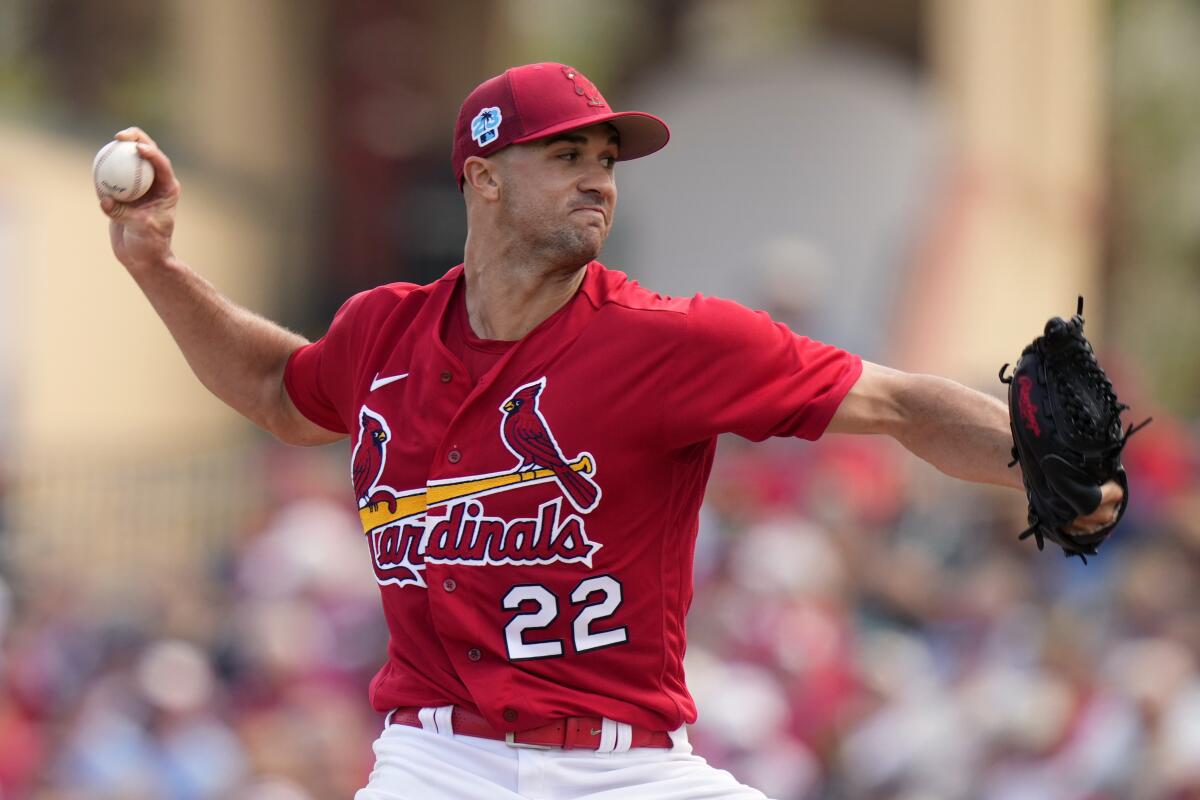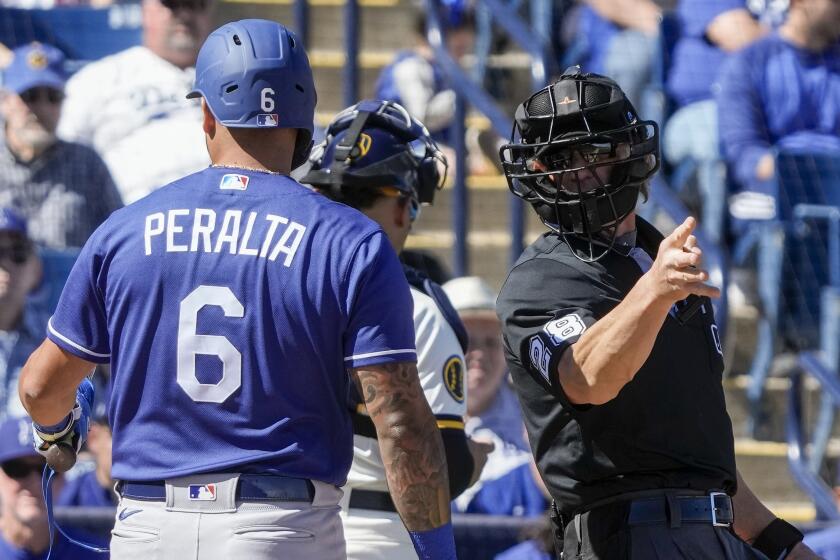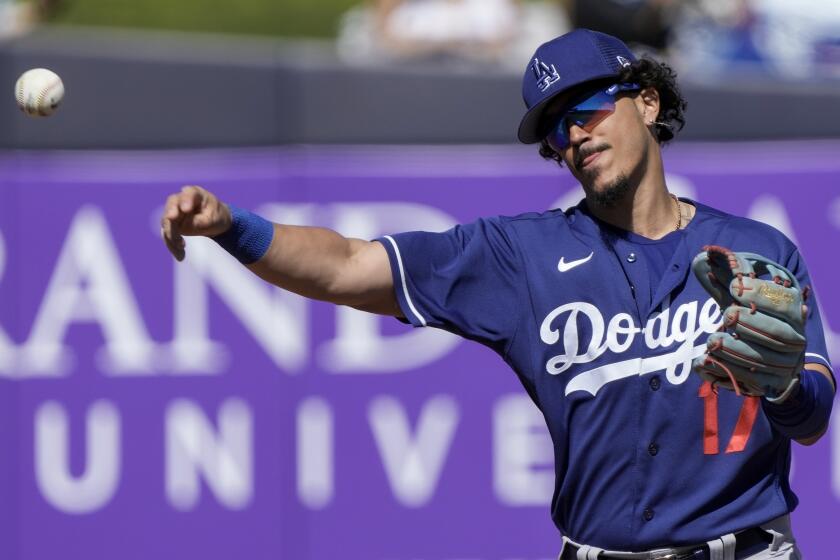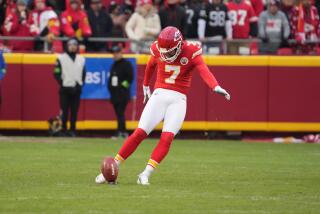Opinion: Baseball’s new pitch clock is the best thing since sliced bread

- Share via
I am a conservative. Radical policy changes to long-standing institutions are naturally worrisome to me.
And so it was as a skeptic that I made my semi-frequent sojourn to Jupiter, Fla., to assess my beloved St. Louis Cardinals as they embarked on another spring training. I was leery not because of the team — no, the Redbirds are in fine shape, and I implore you to learn the name Jordan Walker — but, rather, because of the game’s new rules under which the Cardinals and their Major League brethren will labor this season.
Chief among them is a pitch clock, which enforces that a pitcher must begin his motion toward the plate within 15 seconds of the ball being returned to him, 20 seconds with at least one runner on base, or 30 seconds between batters. Failure to throw a pitch before time runs out results in an automatic ball.
Likewise, if a batter fails to square up in the batter’s box before 8 seconds remain on the pitch clock, he is assessed a strike.
In either case, a trip to the plate can be fundamentally altered if you violate the rules.
It didn’t take long for the Dodgers to see how the pitch clock and new MLB rules for the 2023 season will affect games, and they like the changes.
Major League Baseball has been contemplating a pitch clock for years, as game times pushed to three hours and beyond. To a baseball purist like me, the idea was anathema at first. The national pastime was just about the only major sport that existed with no clock (even the PGA punishes golfers for slow play these days) because baseball wasn’t meant to be rushed but, rather, to be savored.
But after immersing myself in the new world order for a week, I must admit: I love it.
I watched six games, all under three hours. The shortest was 2 hours and 25 minutes, and the longest was 2 hours and 59 minutes. And this was spring training, where lineup and pitching changes are far more plentiful than in regular season tilts.
No more screwing around on the mound. No more stepping in and out of the box to adjust gloves and body armor. No more pacing about in the latter innings by relief pitchers who heretofore treated each pitch like a State of the Union address, whether the game was 1-1 or 12-0.
They just played ball, and at a pace that reminded you of the baseball of your youth. Although I bet there are more than a few stadium operations directors out there calculating how many fewer $7 hot dogs they’ll sell this season.
Angels two-way star Shohei Ohtani throws 34 pitches without a pitch-clock violation Tuesday in a spring training game against the Oakland Athletics.
I kept my eyes on the clock frequently, although it became less important to me as the week wore on. I saw a handful of infractions, but not many. This will ultimately function like the play clock in football, which is rarely violated but potentially consequential when it is. On most pitches, you get a sense of whether the pitcher will make it within the first couple of seconds of his receiving the ball. The clock created a rhythm that was easy to feel as the game went on.
Parents will love the new rules. I have four children — 13, 9, 7 and 5. Ever take four little kids to a baseball game? Three hours-plus seemed like a trip to Mars and back as we shuttled between the concession stands, merry-go-rounds and playground equipment. Was there even a game going on somewhere?
But kids can handle something short of three hours, and you don’t feel like you spent $300 on tickets to see half a game.
I like the play clock so much I’ve started daydreaming about other parts of my life that could use it. Put one over the creamer station at the coffee shop. Put one in airplanes to get dillydallying passengers into their seats. Put one in our minivan to get my kids out of the car in a timely fashion.
The other new rule that’s significant is a ban on “the shift.” In recent years, Major League teams have been overloading one side of the diamond with several fielders, playing the odds that a particular batter would pull the ball. The game’s beautifully symmetric field and corresponding defense had turned into a computer-driven, lopsided mess.
The Dodgers don’t want Miguel Vargas to take swings during games because of a broken pinkie. He’s still found a benefit to the strategy.
Forcing teams to keep two infield players on either side of second base with everyone on the dirt when a pitch is thrown should increase the league’s overall batting average, which fell to .243 last season, the worst in 54 years. More hard-hit grounders will become hits, which means more base runners and more action. All of this serves the game better than letting computers turn it into an algorithmic eyesore.
The bases are slightly bigger this year, but that’s a change you won’t notice, and MLB has also limited pick-off attempts with runners on base, which will marginally speed up play as well.
So far, around the league the new rules have produced the intended results — the overall batting average is up. Scoring is up. And game times are down around 22 minutes.
The game itself — with its steady pace and perfectly conceived symmetry newly restored — is actually enhanced for casual and hard-core fans.
Add the new rules to the National League’s recent adoption of the designated hitter (which puts more runs on the board and increases the lifespan of some of the game’s veteran hitters) and you’ve got the makings of a baseball renaissance.
Just don’t get me started on the ghost runner at second base in extra innings.
Scott Jennings is a former special assistant to President George W. Bush and a senior CNN political commentator. @ScottJenningsKY
More to Read
A cure for the common opinion
Get thought-provoking perspectives with our weekly newsletter.
You may occasionally receive promotional content from the Los Angeles Times.













